Chapter 6 Configuring and Verifying the Components
This chapter describes the steps you take after running the installer. As described in the installation and configuration plan, you begin by starting and verifying the components configured by the installer, and continue by configuring and starting the components that were not configured by the installer.
This chapter describes the configuration and verification steps in the following sections:
-
Starting and Verifying the Directory Server Default Instance
-
Verifying the Access Manager and Portal Server Default Instances
For an overview of the configuration and verification steps, see Developing the Installation and Configuration Plan. For an explanation of the values you input in the configuration wizards, see Installation and Configuration Plan Details.
Starting and Verifying the Directory Server Default Instance
Directory Server provides directory services that support login and authentication for the portal, messaging, and calendar services. You begin verifying your evaluation solution by verifying that you can start and administer the default Directory Server instance.
In this section you learn the following:
-
How to start and stop the Administration Server.
-
How to start and stop Directory Server.
-
How to use the Administration Server console to view the contents of the LDAP directory and verify that Directory Server is correctly configured.
 To Start Administration Server
To Start Administration Server
Before starting the Directory Server default instance, start Administration Server. Administration Server is the administration tool for Directory Server.
Steps
-
Change directory to the server root directory:
cd /var/opt/mps/serverroot
-
Run the command to start Administration Server:
./start-admin
Administration Server starts and displays a series of start-up messages. The startup process might take a few moments. When startup is complete, the following message is displayed:
startup:server started successfully
 To Start the Directory Server Default Instance
To Start the Directory Server Default Instance
After you start Administration Server, start the default Directory Server instance.
Steps
-
Change directory to the directory for the default Directory Server instance. The directory name is includes the unqualified name of the host system.
cd /var/opt/mps/serverroot/slapd-unqualified_evaluation_host
-
Run the command to start Directory Server:
./start-slapd
Directory Server starts without a message.
 To Verify the LDAP Directory Configuration
To Verify the LDAP Directory Configuration
After you start Directory Server, start Server Console and verify the LDAP directory configuration.
Steps
-
Change directory to the serverroot directory:
cd /var/opt/mps/serverroot
-
Run the command to start Server Console:
./startconsole &
The Sun Java System Server Console Login dialog box is displayed.
-
Type your administrator ID (admin) and password (password) and click OK.
The Server Console is displayed, displaying information about the servers and applications in your Administration Server domain. Figure 6–1 shows information for the example.com domain. You see similar information for your domain.
Figure 6–1 Server Console's Servers and Applications Tab
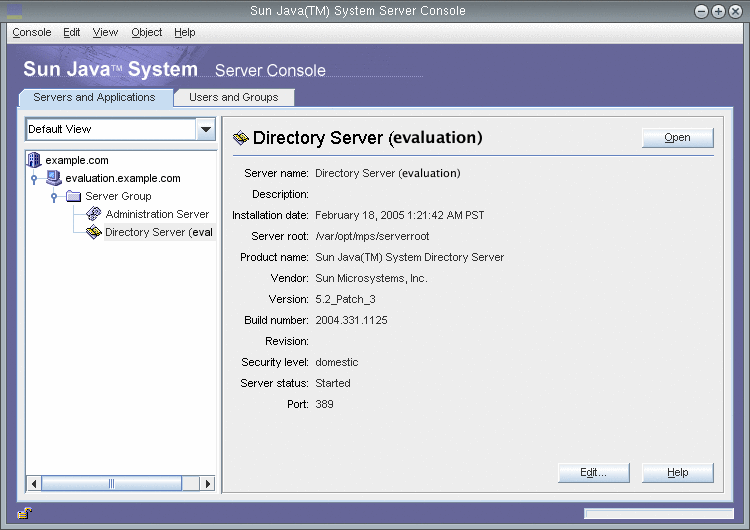
-
Expand the nodes on the Servers and Applications tab and locate the node that represents the default Directory Server instance.
-
The top-level node represents your default Administration Server domain. In Figure 6–1 this is the node labeled example.com.
In your console window, it will be labeled with your evaluation_domain.
-
On the next level, the nodes represent the systems in your Administration Server domain.
In Figure 6–1, the example.com domain includes one system, named evaluation.example.com. In your console window, it will be labeled with your evaluation_host.
-
On the next level is a node labeled Server Group.
This node groups the component instances that are running on your evaluation_host. In Figure 6–1, the Server Group node groups the component instances that are running on evaluation.example.com.
-
On the next level, the nodes represent the individual component instances in your Server Group.
One of these nodes represents the default Directory Server instance. In Figure 6–1, this is the node labeled Directory Server (evaluation.example.com). In your console window it will be labeled Directory Server (evaluation_host).
-
-
Double-click the node that represents your default Directory Server instance.
The Sun Java System Directory Server window is displayed.
-
Click the Directory tab.
The LDAP directory tree is displayed.
Figure 6–2 Default LDAP Directory Tree
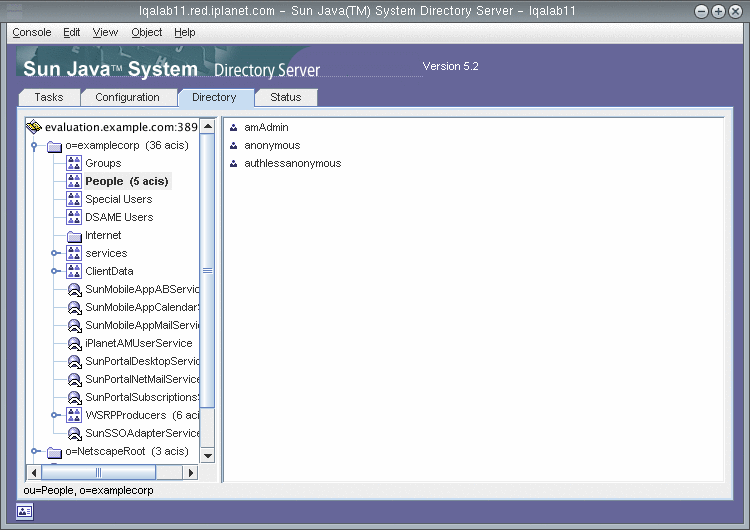
-
Verify the LDAP base suffix set up by the installer.
Your LDAP base suffix is o=examplecorp. You see a display similar to Figure 6–2.
-
Locate the sample LDAP directory entries set up by the installer.
-
Expand the base suffix node (o=examplecorp).
-
Click the People container node.
The right pane displays the contents of the People container. Figure 6–2 shows the People container for the default Directory Server instance on evaluation.example.com. You see a similar display for your Directory Server instance.
-
-
Verify that the People container contains entries for amAdmin, anonymous, and authlessanonymous.
These entries confirm that the Java Enterprise System installer populated the LDAP directory with the sample data you requested during installation.
-
Leave the Server Console running.
Verifying the Access Manager and Portal Server Default Instances
After you start Directory Server, you restart the Web Server default instance. Restarting Web Server also starts Access Manager and Portal Server.
In this section, you learn the following:
-
How to restart Web Server .
-
How to start and stop the Access Manager Administration Console.
-
How use the Access Manager Administration Console to confirm that Access Manager can access your LDAP directory.
-
How to open the sample portal desktop.
 To Restart the Web Server Default Instance
To Restart the Web Server Default Instance
Restarting the Web Server default instance starts two components that run in Web Server’s web container, Access Manager and Portal Server.
Steps
-
Change directory to the Web Server default instance directory. The directory name includes the fully qualified name of the system on which you installed Web Server.
cd /opt/SUNWwbsvr/https-evaluation_host
-
Run the command to restart Web Server:
./stop; ./start
The Web Server displays a sequence of startup messages. The startup process might take a few moments. When startup is complete, the following message is displayed:
startup: server started successfully
 To Log In to Access Manager Administration Console and
Verify Access Manager
To Log In to Access Manager Administration Console and
Verify Access Manager
Logging in to the Access Manager Administration Console confirms that Access Manager is running and verifies that you successfully configured Access Manager to work with your Directory Server instance.
Steps
-
In a web browser, open the following URL:
http://evaluation_host/amconsole/index.html
The Login page is displayed.
-
Type your administration user ID (amadmin) and password (password). Click Log in.
The console displays information about the default Access Manager domain.
-
To confirm that your Access Manager is configured correctly, check the Access Manager domain name.
The Access Manager domain name is displayed in the left panel, just below the Identity Management tab. In Figure 6–3 examplecorp is displayed. You see a similar display on your Access Manager console.
Tip –Examplecorp is the base suffix you established in your LDAP directory tree. When you see it displayed in your Access Manager console, you confirm that Access Manager is communicating with your Directory Server default instance.
Figure 6–3 Access Manager Administration Console
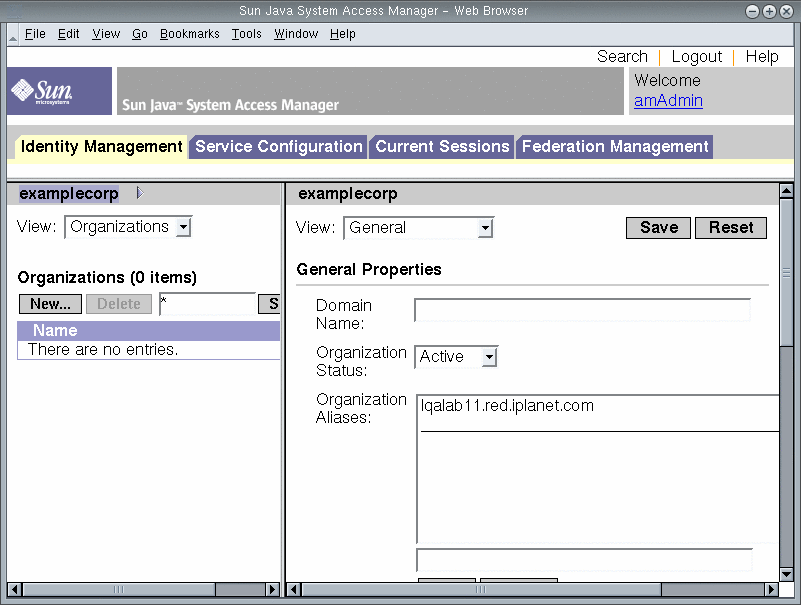
-
Log out of the Administration Console. Click Logout in the upper right corner of the page.
 To View the Sample Portal Desktop and Verify the Default Portal Server Instance
To View the Sample Portal Desktop and Verify the Default Portal Server Instance
The installation procedure in Chapter 5, Installing the Components creates a sample portal desktop. In this section you open the sample portal desktop to verify that Portal Server is running.
Steps
-
In your web browser, open the following URL:
http://evaluation_host/portal/dt
The Portal Server sample desktop is displayed. Figure 6–4 shows the sample desktop. Opening the sample desktop verifies that your default Portal Server instance is running.
Figure 6–4 Sample Portal Desktop
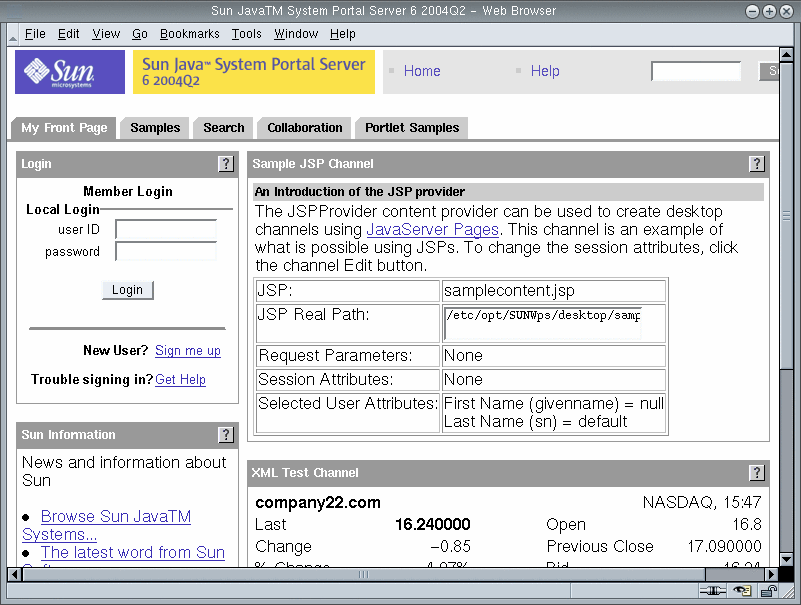
-
Leave the portal desktop open in your browser.
Configuring the Directory for Communications Services
The installation procedure in Chapter 5, Installing the Components creates a directory with a default LDAP schema. Before you configure Messaging Server and Calendar Server instances, you must configure the directory for Java ES communications services. This configuration procedure adds LDAP attributes that support shared user entries. After you complete this configuration, the user accounts in the directory can authenticate through Access Manager and log in to any service provided by a Java ES component.
In this section you learn the following:
-
How to use the Directory Server Preparation Tool to configure your directory tree for communications services.
-
How to use the Administration Console to verify the changes to your directory tree.
 To Configure Your Directory Tree for Communications Services
To Configure Your Directory Tree for Communications Services
This procedure runs the Directory Server Preparation Tool (a Perl script named comm_dssetup.pl) and configures the evaluation directory for use with Java ES communications services. For a summary of the input values, see Directory Server Preparation Tool Details.
Tip –
The script displays a series of prompts. You answer most of the prompts by pressing Enter to accept the default value. The default values identify your default Directory Server instance.
Steps
-
Change directory to the preparation tool directory:
cd /opt/SUNWcomds/lib
-
Run the command that unzips the preparation tool:
unzip dssetup.zip
-
Change directory to the unzipped preparation tool:
cd dssetup
-
Run the command that starts the preparation tool:
perl comm_dssetup.pl
The preparation tool displays a series of messages and then prompts you: Do You Want To Continue? [Y].
-
Press Enter to accept the default value.
The preparation tool prompts you: Enter the Full Path to the Directory Where The Sun ONE Directory Server was Installed.
-
Press Enter to accept the default value (/var/opt/mps/serverroot).
The preparation tool displays a numbered list of directory server instances and prompts you: Which Instance Do You Want? [1].
-
Choose the default Directory Server instance created by the Java Enterprise System installer. For the evaluation solution there is normally only one instance on your evaluation_host.
-
If the default value for this prompt (1) specifies the correct instance (the instance name ends with your evaluation_host), press Enter to accept the default value.
-
If there is more than one Directory Server instance, type in the number that specifies the default Directory Server instance and press Enter.
The preparation tool prompts you: Please Enter The Directory Manager DN [cn=Directory Manager].
-
-
Press Enter to accept the default value (cn=Directory Manager).
The preparation tool prompts you for the Directory Manager password.
-
Type password and press Enter.
The preparation tool prompts you: Will This Directory Server Be Used For Users/Groups? [Yes].
-
Press Enter to accept the default value.
The preparation tool prompts you: Please Enter The Users/Groups Base Suffix [o=examplecorp].
-
Confirm that the default value specifies examplecorp, the base suffix you established for your directory tree. Press Enter to accept the default value.
The preparation tool displays a list of Sun ONE LDAP schemas and prompts you: Please Enter The Schema Type (1, 1.5, 2) [2].
-
Confirm that the default value is 2. Press Enter.
The preparation tool prompts you: Do You Want To Update The Schema Files? [Yes].
-
Press Enter to accept the default value (Yes).
The preparation tool prompts you: Do You Want To Configure New Indexes? [Yes].
-
Press Enter to accept the default value (Yes).
The preparation tool prompts you: Do You Want To Reindex The New Indexes Now? [yes].
-
Press Enter to accept the default value (yes).
The preparation tool displays a summary of the values that you entered and prompts you: Do You Want To Continue? [Y].
-
Review the values you entered. Press Enter to accept the default value (y).
The preparation tool displays a series of informational messages, beginning with “generating files.” This might take a few moments.
The preparation tool generates script files and then prompts you: Ready to execute the script now. Do you want to continue? [Y].
-
Press Enter to accept the default value (Y).
The preparation tool executes the generated scripts to configure the Directory Server instance. This may take a few moments.
The scripts display a long series of informational messages that ends with the following:
Successful Completion
You have configured your directory tree for use with Java ES communications services.
Configuring Messaging Server
In this section you learn the following:
-
How to use the Messaging Server configuration wizard to create and configure a Messaging Server instance.
-
How to start and stop the Messaging Server instance.
-
How to verify the directory tree configuration performed by the Messaging Server configuration wizard.
 To Create and Configure a Messaging Server Instance
To Create and Configure a Messaging Server Instance
This procedure runs the Messaging Server configuration wizard to create and configure a Messaging Server instance. For a summary of the input values, see Messaging Server Configuration Wizard Details.
Steps
-
Change directory to the Messaging Server directory:
cd /opt/SUNWmsgsr/sbin
-
Run the command that starts the configuration wizard:
./configure
The configuration wizard’s Welcome page is displayed.
-
Click Next.
The Fully Qualified Host Name page is displayed.
-
Confirm that the default value specifies your evaluation_host.
Click Next. The Select Directory to Store Configuration and Data Files page is displayed.
-
Click Next to accept the default value of /var/opt/SUNWmsgsr.
The Create New Directory? dialog box is displayed.
-
Click Create Directory.
Tip –If you previously installed and uninstalled Java ES, a different dialog box appears, stating that /var/opt/SUNWmsgsr is not empty. Click Accept Anyway to overwrite the existing instance directory.
The Select Components to Configure page is displayed.
-
Click Next to accept the default values (Message Transfer Agent, Message Store, and Messenger Express are selected).
The Messaging Server User and Group page is displayed.
-
Do the following:
-
In the Enter Username text field, confirm that the default value is mailsrv.
-
In the Enter Group text field, confirm that the default value is mail.
Click Next. The Configuration Directory Server Panel page is displayed.
Figure 6–5 Configuration Directory Server Page

-
-
Do the following:
-
In the Config Server LdapURL text field, confirm that the default value is ldap://evaluation_host :389.
-
In the Bind text field, confirm that the default value is cn=Directory Manager. There must be a space between Directory and Manager.
-
In the Password text field, type password.
Tip –Supplying these values specifies your default Directory Server instance and administrator account.
Click Next. The User/Group Directory Server Panel page is displayed.
-
-
Confirm the following default values:
-
In the User/Group Server LdapURL text field, confirm that the default value is ldap://evaluation_host:389.
-
In the Bind text field, confirm that the default value is cn=Directory Manager. There must be a space between Directory and Manager.
-
In the Password text field, confirm that the default value is password.
Click Next. The Postmaster Email Address page is displayed.
Figure 6–6 Postmaster Email Address Page

-
-
Do the following:
-
In the Enter Email Address text field, type admin@examplecorp.com .
Click Next. The Password For All Admin Accounts page is displayed.
Figure 6–7 Password for All Admin Accounts Page

-
-
Type the following values to establish an administrative password for Messaging Server:
-
In the Enter Password text field, type password.
-
In the Re-enter Password to Verify text field, type password .
Click Next. The Default Email Domain page is displayed.
Figure 6–8 Default Email Domain Page

-
-
Do the following:
-
In the Enter Email Domain text field, type examplecorp.com.
Click Next. The Organization DN for the Default Email Domain page is displayed.
Figure 6–9 Organization DN for the Default Email Domain Page

-
-
Confirm that the default Organization DN is o=examplecorp.com,o=examplecorp.
Tip –The Messaging Server configuration wizard will create a new branch in your LDAP tree, with the name you supply in the Enter Organization DN text field. You add your Java ES users in this branch.
Click Next. The Ready to Configure page is displayed.
-
Review the information. Click Configure Now.
The Ports in Use dialog box is displayed.
Tip –You specify the ports for your Messaging Server instance later in this procedure.
-
Click OK.
The configuration process continues. When the configuration process is complete, the Sequence Completed page is displayed.
-
Click Next.
The Installation Summary page is displayed.
-
Review the installation summary, and then click Close.
-
Change directory to the Messaging Server directory:
cd /opt/SUNWmsgsr/sbin
-
Run the command that specifies the ports for communicating with Messaging Server:
./configutil -o service.http.port -v 88 ./configutil -o service.http.sslport -v 448
-
Run the command that starts Messaging Server:
./start-msg
The startup process displays a series of startup messages. The startup process might take a few moments. When startup is complete, the following message is displayed:
starting job-controller server
You have created and started a Messaging Server instance.
 To Verify that Messaging Server Configuration Modified
the Directory Tree
To Verify that Messaging Server Configuration Modified
the Directory Tree
This procedure describes how to use the Sun Java System Server Console to verify that the Messaging Server added the o=examplecorp.com,o=examplecorp organization to the directory tree.
Steps
-
Return to the Server Console’s Directory Server Window.
-
In the View menu, choose Refresh.
The directory tree display is refreshed.
Figure 6–10 Schema 2 Directory Tree Modified by Messaging Server Configuration
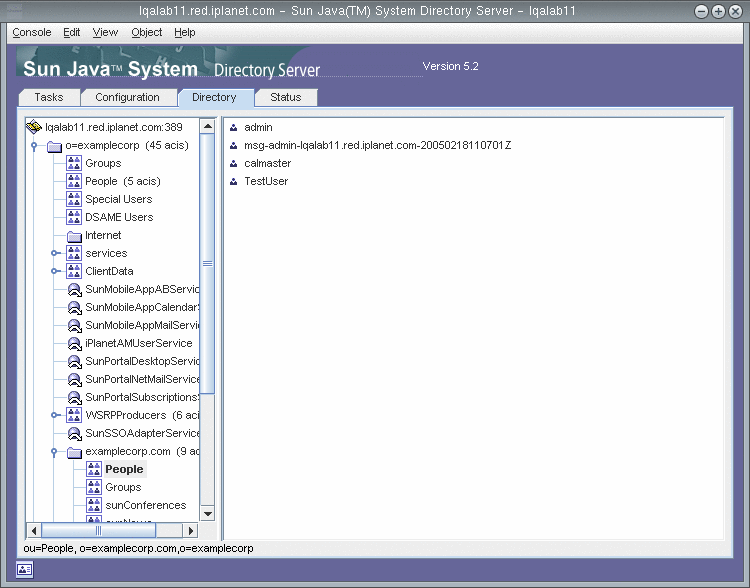
-
Review the modified directory tree.
Confirm that there is a new node for examplecorp.com. Your display should resemble Figure 6–10. The examplecorp.com node represents the LDAP organization created by the Messaging Server configuration tool. The full LDAP DN for the organization is o=examplecorp.com,o=examplecorp.
Tip –Your new LDAP organization supports single sign-on and proxy authentication. When you create LDAP entries for Java ES users, you add them to this LDAP organization.
-
Click the examplecorp.com node.
The right pane displays the contents of the organization.
-
Confirm that the organization has the iplanet-am-managed-people-container object class. Do the following:
-
In the right pane, right-click the People container, and then choose Edit with Generic Editor from the menu.
The generic editor is displayed.
Figure 6–11 Generic Editor

-
In the generic editor, confirm that the object class text field contains iplanet-am-managed-people-container.
This verifies that you have successfully configured your directory tree for Java Enterprise System messaging services.
-
Click OK to close the generic editor.
-
-
Exit the console.
 To Verify Your Messaging Server Instance
To Verify Your Messaging Server Instance
This procedure shows you how to log in to your Messaging Server instance, using the administrator account and the default web interface.
Steps
-
In your web browser, open this URL:
http://evaluation_host:88
The Messenger Express login page is displayed.
-
Type these values:
-
User ID: admin
-
Password: password
Click Log in. The Messenger Express main window is displayed. You see a display similar to Figure 6–12. This confirms that your Messaging Server instance is configured and running.
Figure 6–12 Messenger Express Main Window
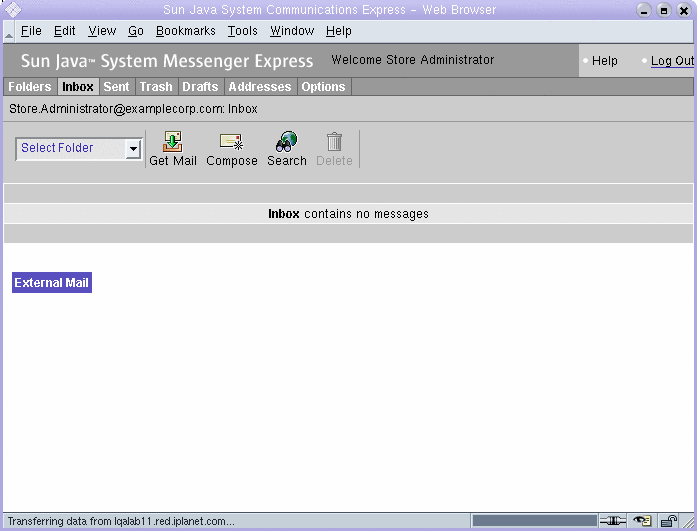
-
-
Click Logout, in the upper right corner of the Messenger Express main window.
This verifies that you successfully configured and started your Messaging Server instance.
Configuring a Calendar Server Instance
In this section you learn the following:
-
How to use the Calendar Server Configuration wizard to create a Calendar Server instance.
-
How to start and stop the Calendar Server instance.
 To Create and Configure a Calendar Server Instance
To Create and Configure a Calendar Server Instance
This procedures runs the Calendar Server configuration wizard to create and configure a Calendar Server instance. For a summary of the input values, see Calendar Server Configuration Wizard Details.
Steps
-
Change directory to the Calendar Server directory:
cd /opt/SUNWics5/cal/sbin
-
Run the command that starts the configuration wizard:
./csconfigurator.sh
The configuration wizard’s Welcome page is displayed.
-
Click Next to continue.
The Administration, User Preferences and Authentication page is displayed.
Figure 6–13 Administration, User Preferences and Authentication Page

-
Do the following:
-
In the LDAP Server Host Name text field, confirm that the default value is evaluation_host.
-
In the LDAP Server Port text field, confirm that the default value is 389.
-
In the Directory Manager DN text field, confirm that the default value is cn=Directory Manager. There must be a space between Directory and Manager.
-
In the Directory Manager Password text field, type password.
-
In the Base DN text field, type o=examplecorp.com,o=examplecorp.
Tip –Your Calendar Server Base DN specifies the LDAP organization (o=examplecorp.com,o=examplecorp) that you created with the Messaging Server configuration wizard.
-
In the Administrator User ID text field, confirm that the default value is calmaster.
-
In the Administrator Password text field, type password.
Click Next. The wizard verifies the connection to the default Directory Server instance. A Question dialog box is displayed.
-
-
Click Create It to create the calmaster user.
The Email and Email Alarms page is displayed.
Figure 6–14 Email and Email Alarms Page
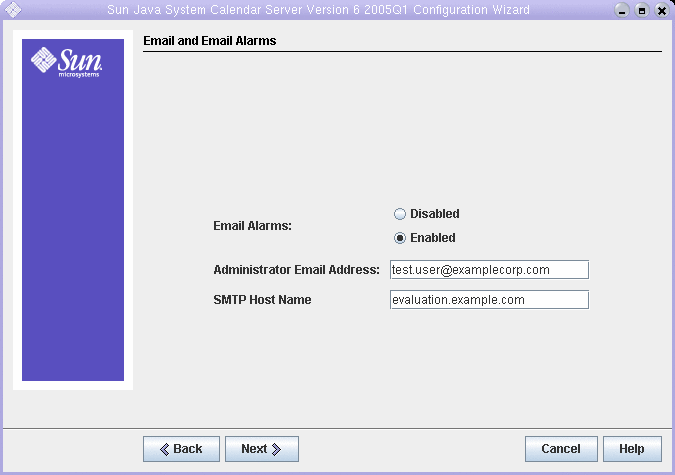
-
Do the following:
-
In Email Alarms, confirm that the default selection is Enabled.
-
In the Administrator Email Address text field, type calmaster@examplecorp.com.
-
In the SMTP Host Name text field, confirm that the default value is evaluation_host.
Click Next. The Problem Connecting to SMTP Host dialog box might be displayed.
-
-
In the Problem Connecting to SMTP Host dialog box, click Accept.
The Runtime Configuration page is displayed.
Figure 6–15 Runtime Configuration Page
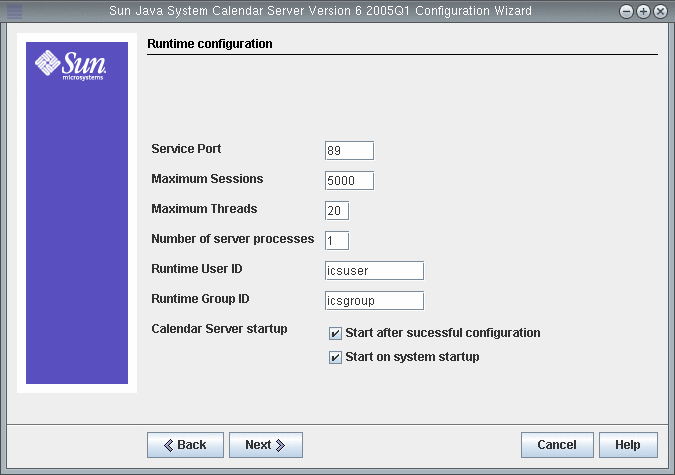
-
Do the following:
-
In the Service Port text field, type 89.
-
In the Maximum Sessions text field, confirm that the default value is 5000.
-
In the Maximum Threads text field, confirm that the default value is 20.
-
In the Number of Server Processes text field, confirm that the default value is 1.
-
In the Runtime User ID text field, confirm that the default value is icsuser.
-
In the Runtime Group ID text field, confirm that the default value is icsgroup.
-
Confirm that Start After Successful Configuration is selected.
-
Confirm that Start on System Startup is selected.
Click Next. The Create New User ID dialog box is displayed.
-
-
Click Create User ID to create the icsuser account.
The Directories to Store Configuration and Data Files page is displayed.
-
Click Next to accept the default values.
The Create New Directory? dialog box is displayed.
Tip –If you previously installed and uninstalled Java Enterprise System, a different message will appear, stating that /var/opt/SUNWmsgsr is not empty. Click to overwrite the existing directory. Do this for each directory.
-
Click Create Directory. Do this for each new directory.
The Archive and Hot Backup Configuration page is displayed.
-
Click Next to accept the default values.
The Create New Directory? dialog box is displayed.
-
Click Create Directory. Do this for each new directory.
The Ready to Configure page is displayed.
-
Click Configure Now.
When configuration is complete, the Configuration Summary page is displayed.
-
Review the details and click Close.
Tip –In the Runtime Configuration page, you selected the Start after successful configuration option. Calendar Server now starts automatically.
 To Verify Your Calendar Server Instance
To Verify Your Calendar Server Instance
This procedure shows you how to verify your Calendar Server instance, using the administrator account and the default web interface.
Steps
-
In your web browser, open the following URL:
http://evaluation_host:89
The Calendar Express Login page is displayed.
-
Type these values:
-
User ID: calmaster
-
Password: password
Click Login. The Calendar Express main window is displayed. You see a display similar to Figure 6–16. This verifies that your Calendar Server instance is correctly configured and running.
Figure 6–16 Calendar Express Main Window
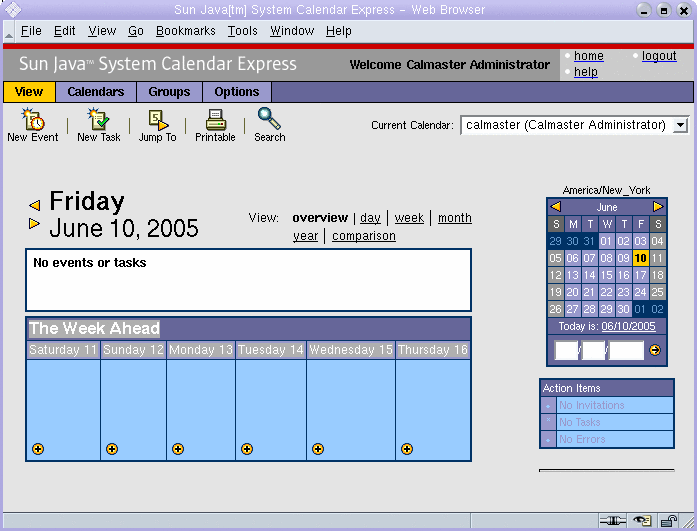
-
-
Click Logout, in the upper right corner of the main window.
This verifies that you successfully configured and started your Calendar Server instance.
Configuring an Instant Messaging Instance
In this section you learn the following:
-
How to use the Instant Messaging Configuration wizard to create an Instant Messaging instance.
-
How to start the Instant Messaging instance.
 To Create and Configure an Instant Messaging Instance
To Create and Configure an Instant Messaging Instance
This procedures runs the Instant Messaging configuration wizard to create and configure an Instant Messaging instance. For a summary of the input values, see Instant Messaging Configuration Wizard Details.
Steps
-
Change directory to the Instant Messaging directory:
cd /opt/SUNWiim
-
Run the command that starts the configuration wizard:
./configure
The configuration wizard’s Welcome page is displayed.
-
Click Next.
The Software Requirements page is displayed.
-
Click Next.
The Select Components page is displayed.
-
Confirm that all three components are selected. Click Next to accept the default selections.
The Network Connection page is displayed.
-
Confirm that the default values identify your evaluation system:
-
In the Host Name text field, confirm that the default value is evaluation_host.
-
In the DNS Domain Name text field, confirm that the default value is evaluation_domain.
Click Next. The IM Server/Identity Server Options page is displayed.
Figure 6–17 IM Server/Identity Server Options Page
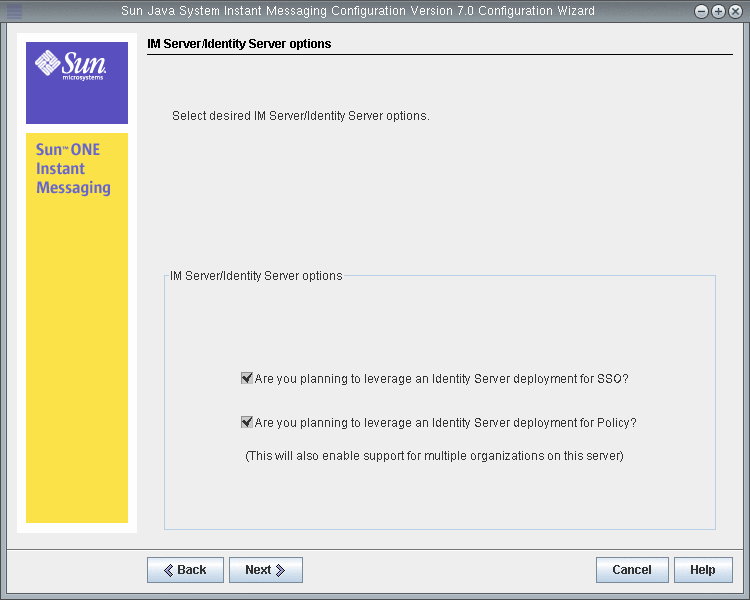
-
-
Select the Single Sign-on (SSO) and Policy Agent options.
Click Next. The Instant Messaging Server Runtime Files Directory page is displayed.
-
Click Next to accept the default value.
A Create Directory dialog box is displayed.
-
Click Create Directory.
The Instant Messaging Server Configuration Page is displayed.
Figure 6–18 Instant Messaging Server Configuration Page
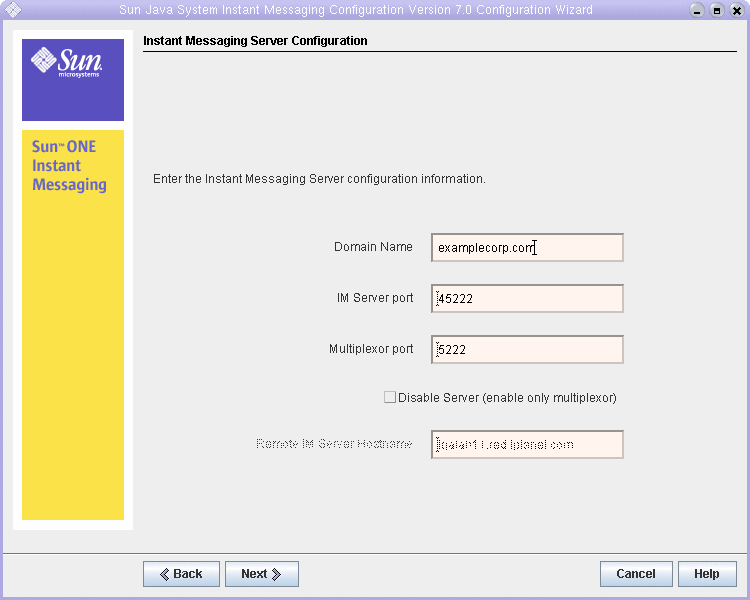
-
Do the following:
-
In the Domain Name text field, type examplecorp.com.
-
In the IM Server Port text field, confirm that the default value is 45222.
-
In the Multiplexor Port text field, confirm that the default value is 5222.
Click Next. The Instant Messaging LDAP Configuration page is displayed.
Figure 6–19 Instant Messaging Server LDAP Configuration Page
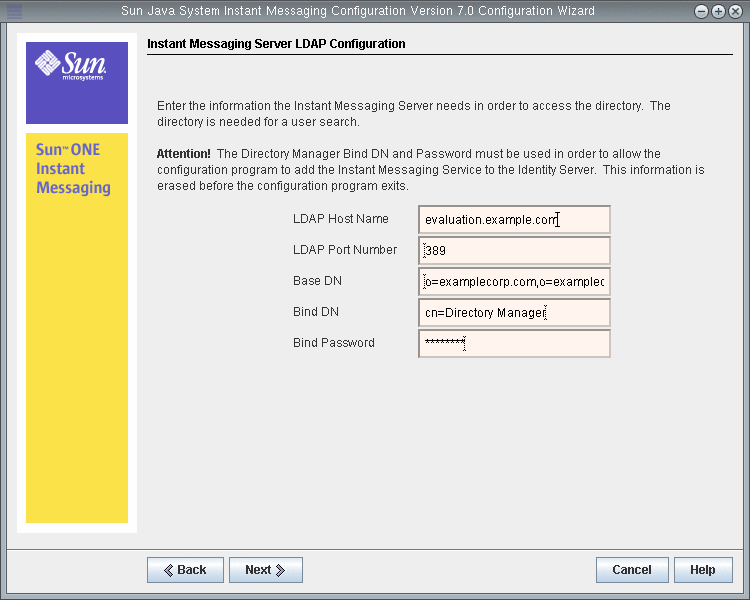
-
-
Do the following:
-
In the LDAP Host Name text field, confirm that the default value is evaluation_host.
-
In the LDAP Port Number text field, confirm that the default value is 389.
-
In the Base DN text field, type o=examplecorp.com,o=examplecorp.
-
In the Bind DN text field, type cn=Directory Manager. You must put a space between Directory and Manager.
-
In the Password text field, type password.
Click Next. The wizard verifies the connection to the default Directory Server instance and the existence of the base DN. The SMTP Service Configuration page is displayed.
-
-
Confirm that the default value in the SMTP Server text field specifies your evaluation_host.
Click Next. The Problem Connecting to SMTP Host dialog box might be displayed.
-
In the Problem Connecting to SMTP Host dialog box, click Accept, and then click Next to continue.
The Select the Codebase for Instant Messaging Services page is displayed.
-
Confirm that the default value in the Codebase text field is http://evaluation_host:80/im.
Click next to accept the default value. The Select Identity Options page is displayed.
-
Click next to accept the default values.
The Instant Messaging Services Startup page is displayed.
-
Confirm that both services are selected.
Click Next. The configuration process begins. The configuration process might take a few moments. When configuration is complete, the Configuration Summary page is displayed.
-
Review the details and click Close.
-
Change directory to the Web Server default instance directory. The directory name includes the fully qualified name of the system on which you installed Web Server.
cd /opt/SUNWwbsvr/https-evaluation_host
-
Run the command to restart Web Server:
./stop; ./start
The Web Server displays a sequence of startup messages. The startup process might take a few moments. When startup is complete, the following message is displayed:
startup: server started successfully
You have created an Instant Messaging instance.
Tip –You use Instant Messaging after you have completed configuration of the LDAP directory tree. For more information, see To Verify Your Test End User Account.
Configuring a Communications Express Instance
In this section you learn the following:
-
How to use the Communications Express Configuration wizard to create a Communications Express instance.
-
How to start the Communications Express instance.
 To Configure a Communications Express Instance
To Configure a Communications Express Instance
This procedures runs the Communications Express configuration wizard to create and configure a Communications Express instance. For a summary of the input values, see Communications Express Configuration Wizard Details.
Steps
-
Change directory to the Communications Express directory:
cd /opt/SUNWuwc/sbin
-
Run the command that starts the configuration wizard:
./config-uwc
The configuration wizard’s Welcome page is displayed.
-
Click Next.
The Select the Directory to Store Configuration and Data Files page is displayed.
-
Click Next to accept the default value of /var/opt/SUNWuwc.
The Create New Directory? dialog box is displayed.
-
Click Create Directory.
Tip –If you previously installed and uninstalled Java ES, a different dialog box appears, stating that /var/opt/SUNWmsgsr is not empty. Click Accept Anyway to overwrite the existing directory.
The Select Components to Install page is displayed.
-
Click Next to accept the default values (Mail Component and Calendar Component are both selected).
The Network Connection page is displayed.
-
Confirm the following default values:
-
In the Hostname text field, confirm that the default value is the unqualified form of your evaluation_host. For example, if you are installing on a system named evaluation.example.com, your default Hostname is evaluation.
-
In the DNS Domain Name text field, confirm that the default value is your evaluation_domain.
Click Next. The Select a Web Container page is displayed.
-
-
Click Next to accept the default values (Web Server is selected).
Click Next. The Web Server Configuration Details page is displayed.
-
Confirm the following default values:
-
In the Server Root Directory text field, confirm that the default value is /opt/SUNWwbsvr.
-
In the Server Instance Identifier text field, confirm that the default value is evaluation_host.
-
In the Virtual Server Identifier text field, confirm that the default value is https-evaluation_host.
-
In the HTTP Port text field, confirm that the default value is 80.
Click Next. The Web Container User and Group page is displayed.
Figure 6–20 Web Container User and Group Page
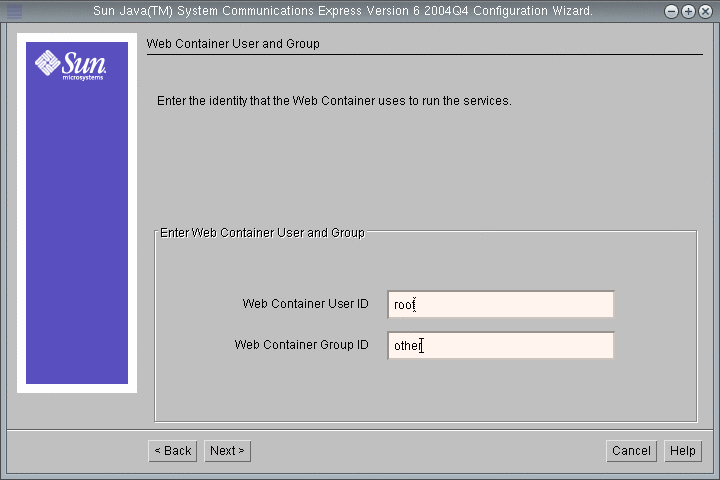
-
-
Do the following:
-
In the Web Container User ID text field, type root.
-
In the Web Container Group ID text field, type other.
Click Next. The URI Path page is displayed.
-
-
Click Next to accept the default value (/uwc).
Tip –Accepting the default value assigns the following URL to your Communications Express instance: http://evaluation_host:80/uwc.
The Do You Want Hosted Domain Support? page is displayed.
-
Click Next to accept the default value (hosted domain support is not selected).
The User/Group Directory Server Details page is displayed.
Figure 6–21 User/Group Directory Server Details Page
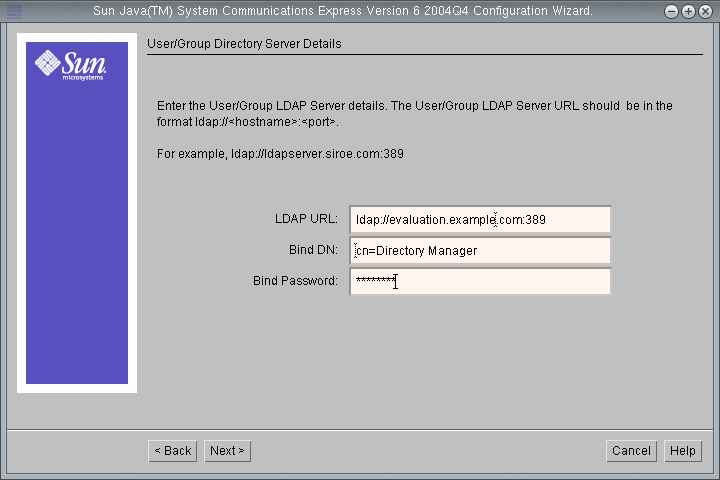
-
Do the following:
-
In the LDAP URL text field, confirm that the default value is ldap://evaluation_host:389.
-
In the Bind DN text field, confirm that the default value is cn=Directory Manager. There must be a space between Directory and Manager.
-
In the Administrator Password text field, type password.
Tip –The values on this page specify your default Directory Server instance.
Click Next. The DC Tree Suffix page is displayed.
-
-
Confirm that the default value is o=examplecorp.
Tip –o=examplecorp is the base suffix you established for the evaluation solution when you installed Directory Server.
Click Next. The Default Domain Name page is displayed.
Figure 6–22 Default Domain Name Page
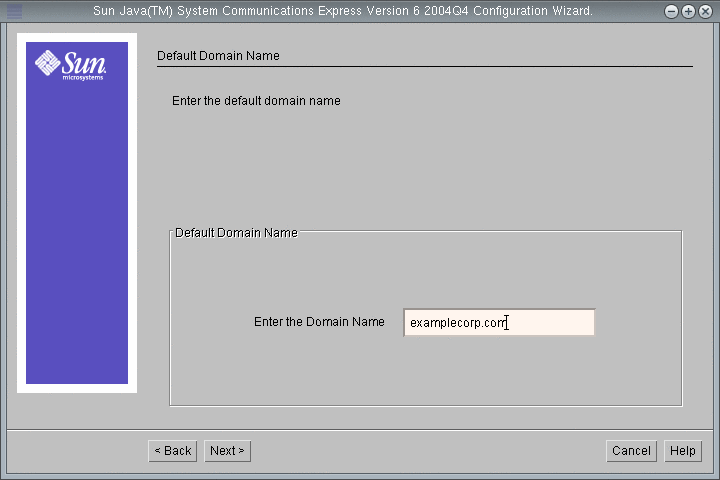
-
In the Enter the Domain Name text field, type examplecorp.com.
Tip –Examplecorp.com is the name of the mail domain you created when you configured your Messaging Server instance.
Click Next. The Identity Server Preferences page is displayed.
Figure 6–23 Identity Server Preferences Page
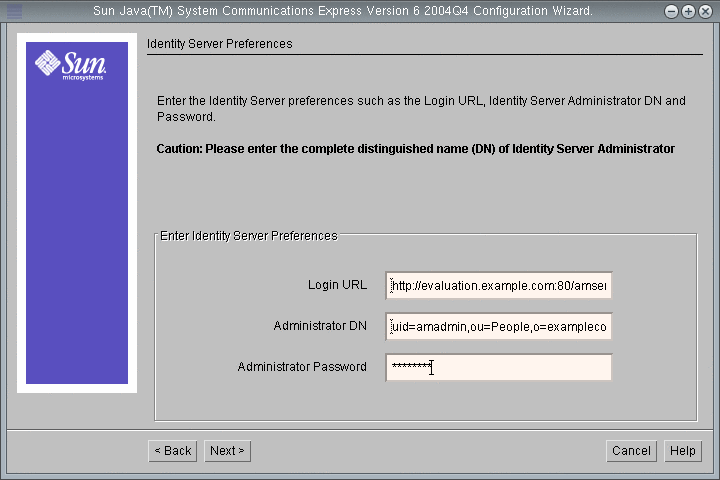
-
Do the following to supply the information needed to identify and connect to your Access Manager instance:
-
In the Login URL text field, confirm that the default value is http://evaluation_host:80/amserver/UI/login.
-
In the Administrator DN text field, type uid=amAdmin,ou=People,o=examplecorp.
-
In the Administrator Password text field, type password.
Tip –The values on this page specify the Access Manager administrator account.
Click Next. The Messenger Express Port page is displayed.
Figure 6–24 Messenger Express Port Page
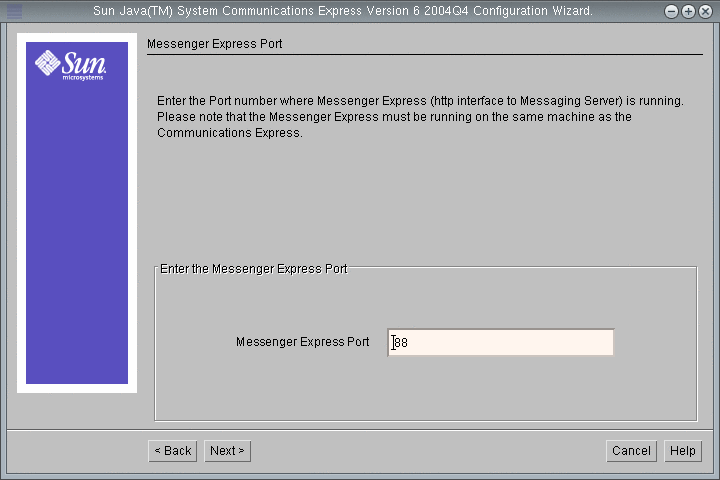
-
-
Do the following:
-
In the Messenger Express Port text field, type 88.
Click Next. The Calendar Server Host and Port Configuration page is displayed.
Figure 6–25 Calendar Server Host and Port Configuration Page
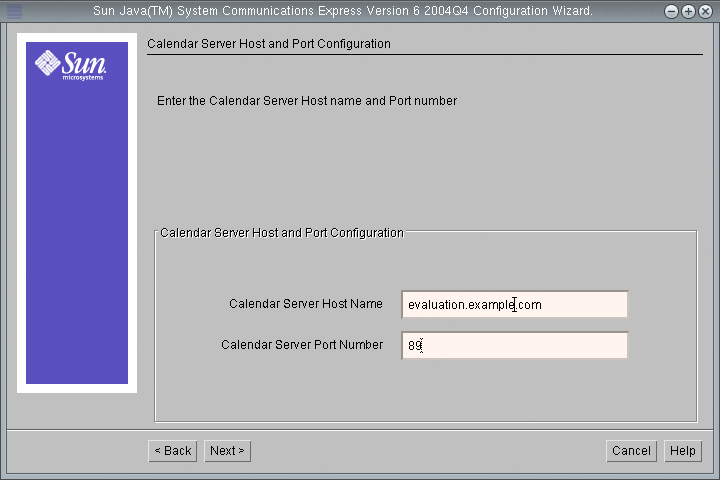
-
-
Type the following values:
-
In the Calendar Server Host Name text field, confirm that the default value is the name of your evaluation_host.
-
In the Calendar Server Port Number text field, type 89.
Click Next. The Calendar Server Administration Details page is displayed.
Figure 6–26 Calendar Administration Details Page

-
-
Do the following:
-
In the Administrator User ID text field, confirm that the default value is calmaster.
-
In the Administrator User Password text field, type password.
Click Next. The PAB Directory Server Details page is displayed.
-
-
Confirm the following values:
-
In the Login URL text field, confirm that the default value is ldap://evaluation_host:389.
-
In the Administrator DN text field, confirm that the default value is cn=Directory Manager. There must be a space between Directory and Manager.
-
In the Administrator Password text field, confirm the default value is password.
Tip –The values on the PAB Directory Server Details page specify your default Directory Server instance.
Click Next. The Ready to Configure page is displayed.
-
-
Review the information. Click Configure Now.
The Starting Task Sequence page displays messages about the configuration process. When the configuration process is complete, the Sequence Completed page is displayed.
-
Click Next.
The Web Server Restart dialog box is displayed.
-
Click OK.
The Configuration Summary page is displayed.
-
Review the configuration summary, and then click Next.
The Post Configuration Instructions page is displayed.
Tip –This document contains the specific post configuration instructions for the evaluation solution.
-
Click Close.
-
Change directory to the Web Server directory:
cd /opt/SUNWwbsvr/https-<evaluation_host\>
-
Run the command that restarts the Web Server:
./stop; ./start
The Web Server displays a sequence of startup messages. The startup process might take a few moments. When startup is complete, the following message is displayed:
startup: server started successfully
You have created and started a Communications Express instance.
Tip –You use Communications Express after you configure the evaluation solution for single sign-on. For more information, see Using Communications Express with Access Manager Single Sign-on
- © 2010, Oracle Corporation and/or its affiliates
